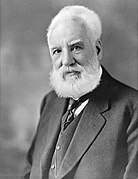
Telecommunication, often used in its plural form or abbreviated as telecom, is the transmission of information with an immediacy comparable to face-to-face communication. As such, slow communications technologies like postal mail and pneumatic tubes are excluded from the definition. Many transmission media have been used for telecommunications throughout history, from smoke signals, beacons, semaphore telegraphs, signal flags, and optical heliographs to wires and empty space made to carry electromagnetic signals. These paths of transmission may be divided into communication channels for multiplexing, allowing for a single medium to transmit several concurrent communication sessions. Several methods of long-distance communication before the modern era used sounds like coded drumbeats, the blowing of horns, and whistles. Long-distance technologies invented during the 20th and 21st centuries generally use electric power, and include the telegraph, telephone, television, and radio.
Early telecommunication networks used metal wires as the medium for transmitting signals. These networks were used for telegraphy and telephony for many decades. In the first decade of the 20th century, a revolution in wireless communication began with breakthroughs including those made in radio communications by Guglielmo Marconi, who won the 1909 Nobel Prize in Physics. Other early pioneers in electrical and electronic telecommunications include co-inventors of the telegraph Charles Wheatstone and Samuel Morse, numerous inventors and developers of the telephone including Antonio Meucci, Philipp Reis, Elisha Gray and Alexander Graham Bell, inventors of radio Edwin Armstrong and Lee de Forest, as well as inventors of television like Vladimir K. Zworykin, John Logie Baird and Philo Farnsworth.
Since the 1960s, the proliferation of digital technologies has meant that voice communications have gradually been supplemented by data. The physical limitations of metallic media prompted the development of optical fibre. The Internet, a technology independent of any given medium, has provided global access to services for individual users and further reduced location and time limitations on communications. (Full article...)
Radar, Aircraft Interception, Mark IV (AI Mk. IV), also produced in the USA as SCR-540, was the world's first operational air-to-air radar system. Early Mk. III units appeared in July 1940 on converted Bristol Blenheim light bombers, while the definitive Mk. IV reached widespread availability on the Bristol Beaufighter heavy fighter by early 1941. On the Beaufighter, the Mk. IV arguably played a role in ending the Blitz, the Luftwaffe's night bombing campaign of late 1940 and early 1941.
Early development was prompted by a 1936 memo from Henry Tizard on the topic of night fighting. The memo was sent to Robert Watson-Watt, director of the radar research efforts, who agreed to allow physicist Edward George "Taffy" Bowen to form a team to study the problem of air interception. The team had a test bed system in flights later that year, but progress was delayed for four years by emergency relocations, three abandoned production designs and Bowen's increasingly adversarial relationship with Watt's replacement, Albert Rowe. Ultimately, Bowen was forced from the team just as the system was finally maturing. (Full article...)
 |
Here are some tasks awaiting attention:
|
John Logie Baird FRSE (/ˈloʊɡi bɛərd/; 13 August 1888 – 14 June 1946) was a Scottish inventor, electrical engineer, and innovator who demonstrated the world's first live working television system on 26 January 1926. He went on to invent the first publicly demonstrated colour television system and the first viable purely electronic colour television picture tube.
In 1928 the Baird Television Development Company achieved the first transatlantic television transmission. Baird's early technological successes and his role in the practical introduction of broadcast television for home entertainment have earned him a prominent place in television's history. (Full article...)

- ... that although Armond Seidler invented the pugil stick for military training purposes, it later found use in the television show American Gladiators?
- ... that Ukrainian actress Oksana Shvets, who was killed in the 2022 invasion of Ukraine, starred in the 2013 joint Ukrainian–Russian television family saga House with Lilies alongside Russian actors?
- ... that the ending of the TV series Community features a fourth-wall-breaking monologue?
- ... that a Nebraska radio station's plans to broadcast college sports were met with "audible gasps"?
- ... that the owner of Mississippi radio stations WGUF and WGUF-FM purposefully fell behind on his royalty payments because he did not like copyright fees?
- ... that former CIA agent Bazzel Baz was hired to be a consultant for The Blacklist television series and instead became a cast member?
The following Wikimedia Foundation sister projects provide more on this subject:
-
Commons
Free media repository -
Wikibooks
Free textbooks and manuals -
Wikidata
Free knowledge base -
Wikinews
Free-content news -
Wikiquote
Collection of quotations -
Wikisource
Free-content library -
Wikiversity
Free learning tools -
Wiktionary
Dictionary and thesaurus





























































































